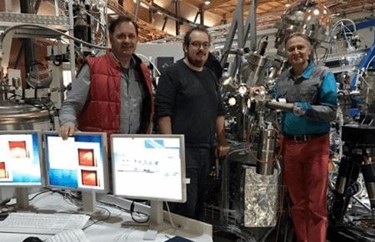Scientists Discover New Multiferroic Material For Quantum Computers
By Jof Enriquez,
Follow me on Twitter @jofenriq

A new class of materials called multiferroic Rashba semiconductors could prove ideal for building spintronic devices and quantum computers, according to scientists at Ecole Polytechnique Federale de Lausanne (EPFL) and the Swiss Light Source (SLS) at the Paul Scherrer Institute (PSI).
Multiferroic materials simultaneously show ferromagnetism and ferroelectricity properties, and allow coupling of electric and magnetic fields. Such materials exploit the intrinsic spin of an electron (and its associated magnetic field), instead, or in addition to the electron charge. The electron spin is a quantum property that can represent an "up" or "down" state simultaneously (similar to Schrödinger's cat being dead and alive at once).
This new area of research, called spintronics, focuses on harnessing electron spin for information transmission and storage in newer, highly-efficient electronic devices. By using multiferroic superconducting materials, through which electrons can move without any loss of energy, physicists hope to build spintronic devices, high-capacity memory cells, and quantum computers that would require significantly less power to store and transmit exponentially huge amounts of data.
One such material was discovered recently by researchers at EPFL and PSI in Switzerland. Using a technique called photoemission, they found that 200 nm-thin sheets of material made of Germanium and Tellurium (GeTe) and doped with Manganese (Mn), were ideal in demonstrating direct multiferroic coupling of ferromagnetic and ferroelectric properties.
“In multiferroic materials the electric and magnetic properties are directly linked,” said Hugo Dil, scientist researcher at EPFL. “So when we switch one the other is affected too, which paves the way to future spintronic devices, since we can switch the magnetic orientation using just a small electrical field.”
Moreover, the GeTe compound belonging to this new class of materials dubbed "multiferroic Rashba semiconductors" or MUFERS, exhibits electric and magnetic polarization that are exactly antiparallel, unlike the few other known multiferroic materials being tested by others.
Furthermore, the properties of MUFERS extend throughout the whole of the material and are not confined to a small region. This has far-reaching implications for the way its electronic states are structured, Dil said in a news release: “In this case the electronic structure is similar to that of topological insulators, but then in 3D. Exactly this property forms the basis for the formation of Majorana particles to be used in quantum computers.”
Dil and colleagues claim that the ability of MUFERS to allow spin manipulation using electrical, as well as magnetic fields, or by combination of both, enhances the functionality of MUFERS devices beyond that of ferromagnetic or ferroelectric systems alone.
Results from this new experiment on materials research are published in Nature Communications.
